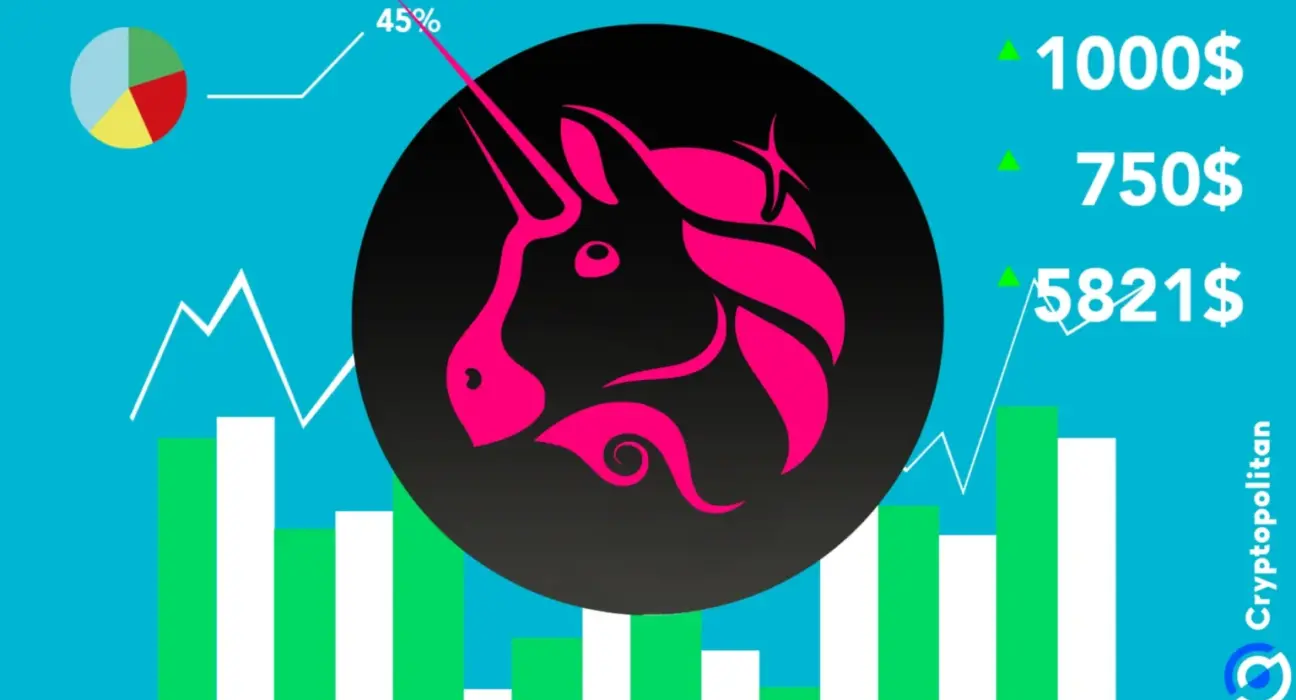In this post:
- All allocations were fully unlocked by Uniswap, although the majority of owners are happy to hold.
- In order to prevent governance attacks that can deplete the community coffers, the Uniswap protocol will prioritize voting security.
- Uniswap is still a DeFi blue chip, and following audits, it is waiting for the deployment of V4 pools.
At this point in its token unlocking journey, Uniswap (UNI) has made 100% of its governance tokens transferable. One of the first venture capital-backed enterprises that distributed profits to token owners was the Uniswap DEX.
The Uniswap (UNI) tokens that were sent finished the unlocking procedure in September. It means that early investors and venture capitalists have all received their payment. Uniswap’s four-year unlocking cycle required the market to absorb a growing quantity of tokens.
Even after the completion of the unlocking schedule, around 600M UNI are reported in circulation out of a total supply of 1B UNI. In total, the Uniswap DEX distributed 15.3% during its airdrop, 43.9% from community farming, and 40.8% to insiders.
Additionally, Uniswap has 430 million tokens in its main treasury, which may have contributed to some of the UNI that were sold. Due to liquidity farming, UNI had a limited initial supply that was quickly used during the 2021 bull market.
Now, the top DEX across more than 16 major chains will need to strike a compromise between the concerns of its powerful VC investors and those of its retail holders and users. One of the best DeFi and DEX platforms is Uniswap, which is seen as the front-runner to resurrect DeFi activity along with Aave.
The purpose of UNI tokens is to reward holding
Consequently, UNI experienced a peak above $42 and then began a prolonged downward trend, presently trading around $6.60. While some of the money from the early wallets was locked for staking or kept in whale wallets, other money was released into the market. UNI might be assigned to additional benefits as well.
With two main investors and 11 participants overall, the DEX raised $176 million in two investment rounds with the assistance of Uniswap insiders. Top Uniswap supporters include Andreessen Horowitz, Polychain Capital, Paradigm, SV Angel, a16v Crypto, and others. Some hope that the backers may wait to sell because they are aware of the pressures on cryptocurrency tokens stems from the existence of funds dedicated specifically to cryptocurrencies.
One of the most powerful VC backers, a16v Crypto, has the potential to alter the Uniswap payout structure. The a16v venture fund recently published a general proposal on its blog regarding the use of app tokens for fee distribution. Uniswap was not specifically mentioned by the venture capital fund, but the fund might have an impact on how the DEX develops in the future.
For rewards, UNI can be staked or utilized in liquidity pools. Uniswap generates up to $2 million in fees every day, providing a reason to remove UNI from circulation for staking. After a vote in May 2024, the fee flip proposal was rejected; nevertheless, it might be brought up again. A mechanism to split DEX swap fees could increase UNI’s value.
Additionally, the timelock smart contract contains a sizable portion of the UNI supply. Changes to the protocol can be proposed and voted on using the tokens included in the contract. Proposals can be made by large owners with more than 2.5 million in their wallet, with a different timelock according on their requirements. A 30-day lockup period is required for certain proposals.
One of the things that keeps insiders and whales from selling their tokens is Uniswap’s governance system. In the event that a DEX comeback is still underway, holding UNI might be particularly desirable. Along with more recent chains like Base, UNI is still regarded as one of the top Ethereum decentralized applications.
Uniswap’s strategy to safeguard its funds
Uniswap is currently working to prevent assaults on its governance protocol. When the number of UNIs assigned to governance is low, a big whale could influence the outcome. A governance attack meant to deplete the coffers poses the greatest threat to Uniswap.
A veto council is one of the recommended protections. A staking requirement, whereby a proposer’s UNI will be reduced in the event that the veto council disapproves, is another potential mechanism under study. Uniswap aims to prevent malicious parties from abusing the protocol.
Uniswap technology gives it a competitive advantage over other DEXs and locks in $4.35 billion in value. About $2.27 billion of that liquidity is carried by Version 3, and V4 of the protocol is presently being tested.
The Base blockchain served as Uniswap’s primary growth engine, providing a platform for meme tokens and comparatively less expensive exchanges. Additionally, Uniswap has begun providing liquidity pools for the recently introduced cbBTC, which includes both the Ethereum and Base versions of the wrapped BTC currency.







